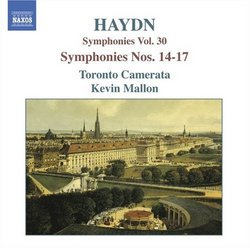| All Artists: Franz Joseph Haydn, Kevin Mallon, Toronto Camerata Title: Haydn: Symphonies Nos. 14-17 Members Wishing: 0 Total Copies: 0 Label: Naxos Original Release Date: 1/1/2006 Re-Release Date: 5/16/2006 Genre: Classical Styles: Historical Periods, Classical (c.1770-1830), Symphonies Number of Discs: 1 SwapaCD Credits: 1 UPC: 747313265626 |
Search - Franz Joseph Haydn, Kevin Mallon, Toronto Camerata :: Haydn: Symphonies Nos. 14-17
 | Franz Joseph Haydn, Kevin Mallon, Toronto Camerata Haydn: Symphonies Nos. 14-17 Genre: Classical
|
Larger Image |
CD Details |
CD ReviewsCharming Early Haydn Symphonies J Scott Morrison | Middlebury VT, USA | 06/18/2006 (5 out of 5 stars) "This CD, along with its soon-to-be-released companion featuring Symphonies Nos. 18-21, performed by the Toronto Camerata conducted by Kevin Mallon, comprise that group's contribution to Naxos's ongoing series of all the Haydn symphonies performed by ensembles from around the world. Kevin Mallon is a rising star among conductors of primarily baroque, rococo and classical music with his groups in Toronto, this chamber orchestra plus his vocal/instrumental group, Aradia. He was concertmaster of William Christie's Les Arts Florissants and later of Toronto's Tafelmusik, having been educated in Belfast and Manchester and having studied conducting with John Eliot Gardiner. His work is notable for its limpid grace, clarity and dramatic aptness. That is certainly in evidence in this recording.
Haydn's Symphonies 14-17 were written in the few years after 1760 when he was in his late twenties and bent on polishing the form that was later to be known as the model for the classical symphony. As the Grove Dictionary states, 'There is no other genre in Western music for which the output of a single composer is at once so vast in extent (106 works), so historically important and of such high artistic quality.' He kept writing them, of course, until the 1790s. We are typically more familiar with those latter works, but these early works deserve some attention. Nos. 14 and 15 are in the usual four movements, Nos. 16 and 17 have only three. No. 17 is the earliest and is the last he wrote before he took up his position at Eszterhaza; stylistically it is of a piece with the others presented here. The mood of these symphonies is generally light, in keeping with the generally diverting intention of rococo orchestral music, but there are hints of deeper things in the Andantes of Nos. 14, 15 and 16. The opening movement of No. 15 is probably the most forward-looking of those heard here: in it one hears themes manipulated in a 'modern' manner, and they are echoed in its later movements. These performances are by the Toronto Camerata, a 24-member group made up of members Toronto's principal orchestras -- the Toronto Symphony, Tafelmusik, the Canadian Opera and Ballet orchestras. (All the instrumentalists are named in the booklet, a move I strongly approve; symphonic musicians all too often labor in anonymity.) Although the group is relatively newly formed, it is clearly a crack outfit, well-versed in 18th century performance technique and practice, and responsive to Mallon's sensitive direction. TT=68:42 Scott Morrison" |

 Track Listings (14) - Disc #1
Track Listings (14) - Disc #1